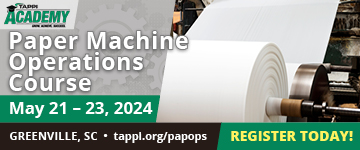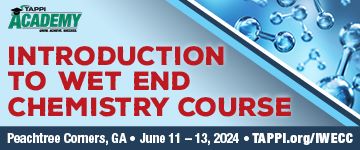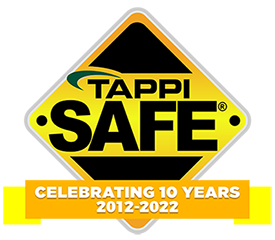 Search
Search
Use the search bar or filters below to find any TAPPI product or publication.
Filters
Content Type
Publications
Level of Knowledge
Collections
Magazine articles

Highly corrosion-resistant metals for the pulp and paper industry, TAPPI JOURNAL, March 1991, Vol. 74(3)
Highly corrosion-resistant metals for the pulp and paper industry, TAPPI JOURNAL, March 1991, Vol. 74(3)
Magazine articles

Drying: New lime mud dryer kiln helps James Riverâ??s Pennington, AL, mill meet environmental restrictions, December 1995 Tappi Journal [95Dec37.pdf]
New lime mud dryer kiln helps james river's pennington, al, mill meet environmental restrictions, TAPPI JOURNAL, December 1995, Vol. 78(12)
Magazine articles

Capital cost analysis looks at recent and future trends, TAPPI JOURNAL, November 1992, Vol. 75(11)
Capital cost analysis looks at recent and future trends, TAPPI JOURNAL, November 1992, Vol. 75(11)
Magazine articles

1994 polymers, laminations and coatings conference highlights technology basics, TAPPI JOURNAL, December 1994, Vol. 77(12)
1994 polymers, laminations and coatings conference highlights technology basics, TAPPI JOURNAL, December 1994, Vol. 77(12)
Journal articles

Magazine articles

Incorporation of post-consumer pizza boxes in the recovered fiber stream: Impacts of grease on finished product quality, TAPPI Journal March 2021
ABSTRACT: Grease and cheese contamination of used pizza boxes has led to misunderstanding and controversy about the recyclability of pizza boxes. Some collection facilities accept pizza boxes while others do not. The purpose of this study is to determine whether typical grease or cheese contamination levels associated with pizza boxes impact finished product quality. Grease (from vegetable oil) and cheese are essentially hydrophobic and in sufficiently high concentration could interfere with interfiber bonding, resulting in paper strength loss.Findings from this study will be used to determine the viability of recycling pizza boxes at current and future con-centrations in old corrugated containers (OCC) recovered fiber streams. These findings will also be used to inform the acceptability of pizza boxes in the recycle stream and educate consumers about acceptable levels of grease or cheese residue found on these recycled boxes.
Journal articles

Magazine articles

Ultrastructural Behavior of Cell Wall Polysaxxharides, TAPPI Journal April 2022
ABSTRACT: Considerable information on the ultrastructural organization of the plant cell wall and the supermolecular arragement of the cell wall components, in particular of cellulose, has been obtained with the electron microscope.
Magazine articles

China: now and in the future, TAPPI JOURNAL, May 1996, Vol. 79(5)
China: now and in the future, TAPPI JOURNAL, May 1996, Vol. 79(5)
Magazine articles

A personal mount st. helens experience, TAPPI JOURNAL, May 2000, Vol. 83(5)
A personal mount st. helens experience, TAPPI JOURNAL, May 2000, Vol. 83(5)
Journal articles

Magazine articles

The role of hornification in the deterioration mechanism of physical properties of unrefined eucalyptus fibers during paper recycling, TAPPI Journal February 2024
ABSTRACT: Physical properties of cellulosic paper deteriorate significantly during paper recycling, which hinders the sustainable development of the paper industry. This work investigates the property deterioration mechanism and the role of hornification in the recycling process of unrefined eucalyptus fibers. The results showed that during the recycling process, the hornification gradually deepened, the fiber width gradually decreased, and the physical properties of the paper also gradually decreased. After five cycles of reuse, the relative bonding area decreased by 17.6%, while the relative bonding force decreased by 1.8%. Further results indicated that the physical property deterioration of the paper was closely related to the decrease of fiber bonding area. The fiber bonding area decreased linearly with the reduction of re-swollen fiber width during paper recycling. Re-swollen fiber width was closely related to the hornification. Hornification mainly reduces the bonding area of unrefined eucalyptus fiber rather than the bonding force. The work elucidates the role of hornification in the recycling process of unrefined eucalyptus fibers and the deterioration mechanism of paper physical properties, which will be helpful to control the property deterioration of paper and achieve a longer life cycle.
Magazine articles

Views from the top: ceos offer global perspectives on the pulp and paper industries, TAPPI JOURNAL, August 1999, Vol. 82(8)
Views from the top: ceos offer global perspectives on the pulp and paper industries, TAPPI JOURNAL, August 1999, Vol. 82(8)






